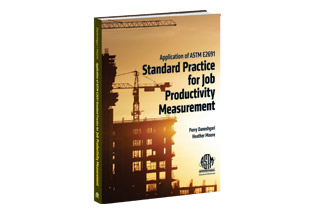
Construction Job Productivity Measurement
A How-To with ASTM Manual 65
As the saying goes, time is money.
That's true for many projects, construction and otherwise, and measurement can lead to process improvements and resulting savings. But how do you decide what to measure and how to measure so that you can make process improvements and reduce costs?
Use job productivity measurement.
JPM is a measurement method, with an associated manual based on an ASTM International standard that addresses the topic. The standard is E2691 and the book is ASTM Manual 65, Application of ASTM E2691, Standard Practice for Job Productivity Measurement, by Perry Daneshgari, Ph.D., and Heather Moore. Daneshgari is president and CEO of MCA Inc., Flint, Mich., and Moore is vice president of operations for the company.
Daneshgari and Moore say that, prior to the manual's publication, they received a considerable number of requests from industry for information about using E2691 and JPM. "The construction industry is at a historical inflection point, [changing] from a skilled trade to industrial driven production," they say. In response, Daneshgari and Moore created the manual to expose the reader to the principles behind the standard and its application in the construction industry.
Job productivity and its deviation from the expected outcome is the foundation of the standard and the manual. The reader will learn how the ratio of labor resources used to the actual transferred value to the end user quantifies the effectiveness of production. The calculation compares how much effective work is put in place, versus the number of available labor hours. That work is what has been designed, planned, laid out, installed or fabricated.
To achieve such measurements, the user of JPM breaks a project into tasks and cost codes. To interpret the results, statistical process control tools and methods are used. Using an industrial engineering approach, this method will take into account installation difficulties at any given point on a job. JPM also enables the evaluation of relative productivity changes.
Through the manual, Daneshgari and Moore treat the JPM topic comprehensively. The authors document two JPM add-ons, as referenced in the book's introduction, that (1) promote more realistic approaches for recognizing revenue, and (2) identify the special and common causes affecting project progress and performance.
The first six chapters include technical foundations for JPM and the E2691 standard. The chapters are a guide to:
- Introduce the topic and JPM;
- Explore the difference between construction output and outcome;
- Emphasize visibility through statistical process control and related checks;
- Focus on construction financial models and how they affect the bottom line;
- Describe construction productivity measurement methods; and
- Explain the JPM standard practice.
The final chapter features case studies that apply JPM. The illustrations of applying the methodology include the task of an office electrical service installation, the project of constructing a new commercial office or renovating an existing facility, and a conceptual study of applying JPM at the industry level.
Three appendixes round out the book and give further insight on the following topics:
- Exploring the individual issues with production and their cumulative impact;
- Applying JPM to improve contract billing; and
- Resources to check for additional information.
The JPM method's principles, ease of application and 20 years of use in the built environment, say Daneshgari and Moore, lay the foundation for the manual's and the standard's use. Their use will improve productivity, profitability and company competitiveness.
 SN Home
SN Home Archive
Archive Advertisers
Advertisers Masthead
Masthead RateCard
RateCard Subscribe
Subscribe Email Editor
Email Editor